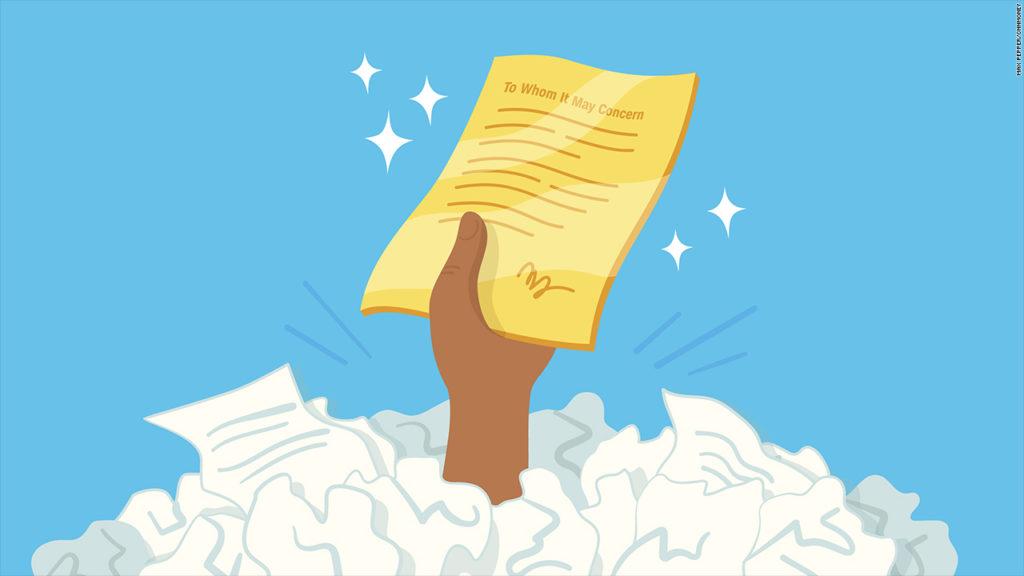“Do I really need to submit a cover letter? Like, really, do I HAVE to?” “What would happen if I submitted the application without it?” Those are the most common questions I have heard from students about writing cover letters. My personal favorite? “What is a cover letter?” and the response after I explain it, “Who has time to read or write that?!”
Trust me, I KNOW. They are time consuming. They are repetitive. They are, well, not fun to write. BUT they ARE necessary. Even in 2022, most job postings that you see are asking for interested candidates to submit a cover letter with the resume and other materials. So, knowing that you have to write one for your job applications (and yes, you do need to customize each one for each job you are applying for), let’s explore cover letters and the proper formatting so you can be prepared.
What is a cover letter?
Your cover letter (also known as a letter of interest or application letter) is a document you send with your resume that provides additional information about skills and experiences related to the job you’re applying to. It typically includes three to four paragraphs and follows the format of a business letter. It is not a duplication of what is on your resume. Think of a cover letter as a self-marketing tool. Most of the time, the employer reviewing your resume and your application does not know you. Unless they have Google searched you or looked you up on social media, your employment documents are what they use to create their first impression of you. If you really want the job, having a well-crafted cover letter that aligns with the job description is a very powerful tool to have in your toolbox. It is your opportunity to personalize your documents and provide real life examples of work you have accomplished demonstrating why you meet the qualifications for the role. A cover letter is no longer than one page and is always left justified (meaning each new line is aligned on the left margin, no indent for new paragraphs).
How do I format a cover letter? What goes in each section?
Paragraph 1
As previously stated, your cover letter is broken up into three or four paragraphs. Your first paragraph is the introductory section. Here, you will state the position you are interested in and applying for, why you are interested in this particular opportunity with this specific employer, and why you believe you would be a good fit for the position. If someone referred you to this position, you want to mention that in this section. This paragraph is not long, and is typically no more than three to five sentences. An example is below:
“I am reaching out to you today in regards to the ______ position that is currently posted with _______ in _______ (city, state). I would like to take this opportunity to present my experience in office administration, direct patient care, customer service, as well as training and development. I have over seven years of experience in the healthcare industry from previous roles, including my most recent position as an Assistant Manager for a small, private practice in the area. Providing administrative support and direct patient care is something I have exceptional experience in delivering.”
That’s it! It really doesn’t need to be more complicated than that. It should be organized appropriately and be professional and to the point.
Paragraph 2 (and perhaps 3)
This is what I like to call the “meat and potatoes” of your letter. This is the good stuff. The filling stuff. The stuff that is going to make the employer say “Wow, this candidate sounds amazing, I can’t wait to give them a call!” Your middle paragraph(s) should highlight your qualifications. It should make direct connections from your resume and relevant experiences, matching what the employer is looking for and the minimum requirements for the position. Having the job description or job advertisement handy is a very good idea when you are crafting each one of your cover letters. Yes, you will need to write one for each job that requests it AND tailor each cover letter for every position that you apply to! I know. So much work to get a job. Hence my favorite quote for job seekers, “It is a job to find a job.”
In these paragraphs, give examples and details of your background that will show the reader why they should consider you as a candidate. Explain to the reader how you have done the types of tasks they are looking for before. I don’t recommend giving any more than two or three really good examples, you don’t want your cover letter to be a book. If you have had relevant experience or related education, be sure to link your experiences and/or education to the position. Also, remember that the reader will view your letter as an example of your writing skills, so make sure to have it proofread or that you read it out loud to yourself to catch any grammatical errors or typos. In addition to work experience and education, you can talk about internships and volunteer work as well.
Concluding Paragraph
In your closing paragraph, reiterate your interest in the position, thank the employer for his/her consideration, provide your contact information, and indicate the follow-up action (if you do indeed plan to follow-up with them). State what you want the recipient of the letter to do next (such as contacting you to further discuss the available position) or what you will do next (such as calling to follow-up on the status of your application). I can’t express enough how important it is to thank the reader for their time. Many applicants do not do this or include a recognition of appreciation. If you do, it will be remembered and could help you stand out amongst other applicants.
Complimentary Close
Just like you would sign a business letter or an official email with a signature, you cover letter requires one as well. I recommend using “Sincerely” followed by four spaces, if you are going to sign your name. On the fourth space, you would type your name, and your hand-written signature goes in the middle. If you do NOT plan to hand sign your name, you can simply type your name underneath.
That’s it! The hardest part of writing the cover letter is the middle section. You really need to have a good understanding of your experiences and how they relate to the position you are applying for. My recommendation is to NOT use a template. HR managers, talent acquisition specialists, and other hiring managers can tell when you have not taken the time to customize your own letter. Trust me, I have been doing this for 12 years and I can easily tell when the student has written their own letter and when they have submitted a template for a grade. Don’t do it. You won’t get contacted for the job, and if you do, you’ll be asked to talk about what you’ve submitted, so it’s best practice to not use templates.
Please reach out to me at kate@hwny.org if you would like assistance crafting a unique cover letter for a job application!




